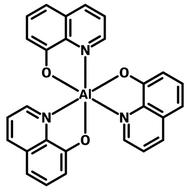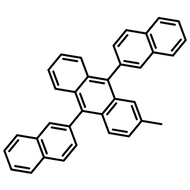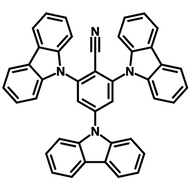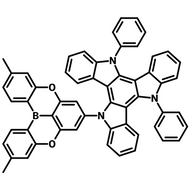Dopant Materials
Dopant materials play a crucial role in enhancing luminescence, colour purity, and energy transfer. These dopants are incorporated into the host material of the organic light emitting diode (OLED) or thermally activated delayed fluorescence (TADF) layers, improving the resultant devices performance, colour quality, and efficiency. Maximize your device efficiency further by fabricating and testing new devices in a glove box environment.
OLED dopant materials are often found as a central metal atom surrounded by organic ligands that control the energy levels and emission wavelength. These ligands can also be selected to enhance the solubility and processability within the host material.
TADF dopant materials feature donor-acceptor molecular structures that lead to energy differences in excited states, generating fluorescence via efficient reverse intersystem crossing. The structure and spatial arrangement of the donor and acceptor units play a key role. Respectively ensuring the LUMO and HUMO align well with the host material for efficient charge transport and effective charge separation and stabilisation.
Small amounts of these materials are able to introduce large changes in the performance and are thus critical tools in the design of light emitting devices. Explore our collection of blue, green, and red dopant materials for OLEDs and TADF devices.
Jump to: Browse Dopant Materials by Collection | Browse all Dopant Materials | Resources and Support
Browse Dopant Materials by Collection
Browse Dopant Materials
Related categories: OLED materials, transport layer materials, OLED host materials, TADF materials
Filter by price change:
Filter by colour:
Filter by purification technique:
Page 1 of 3
Resources and Support
Fluorescence and phosphorescence are types of photoluminescence. Photoluminescence refers to radiative emissions where the absorbance of a photon is followed by the emission of a lower energy photon. The main empirical difference between fluorescence and phosphorescence is the time in between absorbance and the emission of photons. Fluorescence is where a material absorbs a photon, and almost immediately emits a lower energy photon.
Read more... Organic Light Emitting Diodes
Organic Light Emitting Diodes
Organic light emitting diodes are thin film devices that convert electrical energy into visible light. In OLED devices, electrons and holes are injected into the organic medium and recombine radiatively via electroluminescence (EL). The colour of the light emitted is dependent on the molecular structure of the organic material. This can be easily customized to make a wide range of wavelengths thanks to the endless configurations of organic molecules.
Read more...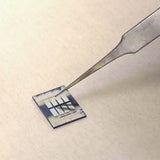 OLED Fabrication Guide
OLED Fabrication Guide
In this guide, we demonstrate how to make standard OLED devices in a glove box using materials and equipment easily available to any lab. Find out more.
Read more... OLED Testing Guide
OLED Testing Guide
This guide gives you an overview of what to consider when characterising an OLED, as well as tips for their measurement.
Read more...




